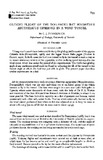| dc.description.abstract | 1. A bat was trained to fly in a tilting wind tunnel. Stereoscopic photographs were taken, both by reflected and by transmitted light, and measurements of best gliding angle were made.
2. Variation of wing span and area at different speeds was much less than in birds. This is attributed to the construction of the wing, which prevents the bat from folding back the manus in flight, because this would lead to collapse of the plagiopatagium.
3. The trailing edge of the wing is normally deflected upwards in flight, at least in the distal parts. This is interpreted as providing longitudinal stability. The plagiopatagialis proprii muscles appear to act as an elevator, by deflecting the trailing edge of the plagiopatagium upwards.
4. The speed range over which the bat could glide was 5·3-11·0 m/s. Its maximum lift coefficient was 1·5, and its best glide ratio 6·8:1. The Reynolds number range, based on mean chord, was 3·26 x 104 to 6·79 x 104.
5. A simple regression analysis of the glide polar indicated a very high span efficiency factor (k) and low wing profile drag coefficient (Cdp). On the other hand, a drag analysis on the assumption that k = 1 leads to an improbably large increase in the estimated Cdp at low speeds. It is suggested that the correct interpretation probably lies between these extremes, with k ≊ 1·5; Cdp would then be about 0·02 at high speeds, rising to somewhat over 0·1 at the minimum speed.
6. It would appear that the bat is not so good as a pigeon at fast gliding, but better at low-speed manoeuvring. On most points of performance, however, the two are remarkably similar. | en_US |

